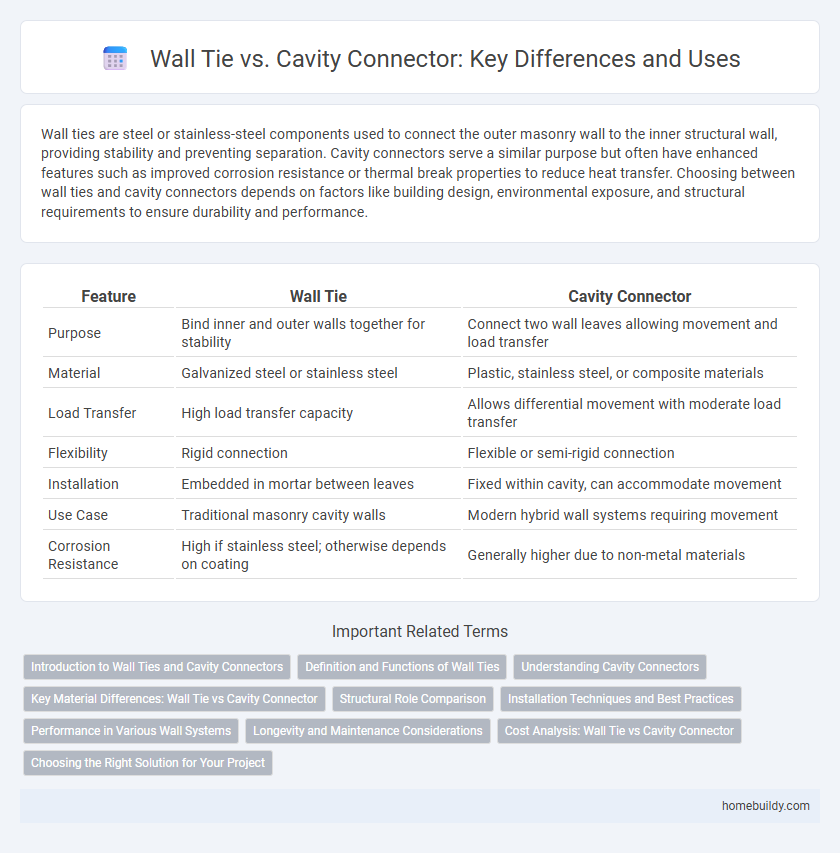Wall ties are steel or stainless-steel components used to connect the outer masonry wall to the inner structural wall, providing stability and preventing separation. Cavity connectors serve a similar purpose but often have enhanced features such as improved corrosion resistance or thermal break properties to reduce heat transfer. Choosing between wall ties and cavity connectors depends on factors like building design, environmental exposure, and structural requirements to ensure durability and performance.
Table of Comparison
| Feature | Wall Tie | Cavity Connector |
|---|---|---|
| Purpose | Bind inner and outer walls together for stability | Connect two wall leaves allowing movement and load transfer |
| Material | Galvanized steel or stainless steel | Plastic, stainless steel, or composite materials |
| Load Transfer | High load transfer capacity | Allows differential movement with moderate load transfer |
| Flexibility | Rigid connection | Flexible or semi-rigid connection |
| Installation | Embedded in mortar between leaves | Fixed within cavity, can accommodate movement |
| Use Case | Traditional masonry cavity walls | Modern hybrid wall systems requiring movement |
| Corrosion Resistance | High if stainless steel; otherwise depends on coating | Generally higher due to non-metal materials |
Introduction to Wall Ties and Cavity Connectors
Wall ties are metal components designed to connect masonry walls to their supporting structure, ensuring stability and preventing wall separation. Cavity connectors serve a similar purpose but are specifically engineered to bridge the cavity between outer and inner walls, enhancing structural integrity and moisture resistance. Both elements are critical in cavity wall construction, providing lateral support while accommodating movement and preventing water penetration.
Definition and Functions of Wall Ties
Wall ties are metal components used to connect the outer and inner walls of cavity wall structures, ensuring structural stability and load transfer between the two. Their primary function is to prevent lateral movement and distribute wind loads uniformly, thereby enhancing the overall integrity of the building facade. Unlike cavity connectors, which mainly serve as spacers to maintain wall cavity width, wall ties also contribute significantly to moisture control and resistance to wall separation.
Understanding Cavity Connectors
Cavity connectors are specialized components used in masonry construction to secure inner and outer walls, providing structural stability while preventing moisture transfer. Unlike traditional wall ties, cavity connectors often feature enhanced corrosion resistance and thermal efficiency, making them ideal for cavity wall systems. Their design allows for controlled movement between wall leaves, reducing stress and improving the longevity of the masonry structure.
Key Material Differences: Wall Tie vs Cavity Connector
Wall ties are typically made from galvanized steel, stainless steel, or plastic, providing corrosion resistance and structural strength to secure masonry walls. Cavity connectors often use stainless steel or high-strength composite materials designed to accommodate movement between inner and outer wall leaves. The primary material difference lies in the adaptability of cavity connectors for dynamic loads, whereas wall ties focus on fixed, rigid connections.
Structural Role Comparison
Wall ties primarily provide structural integrity by linking the outer masonry wall to the inner frame, ensuring stability and load distribution. Cavity connectors serve a similar structural role but are designed to bridge the gap between two wall leaves, often offering enhanced resistance against lateral forces and thermal movement. Both elements are crucial in preventing wall separation, but cavity connectors typically deliver improved performance in modern cavity wall construction.
Installation Techniques and Best Practices
Wall ties require precise alignment and secure fixing within mortar joints to ensure optimal load distribution and structural stability, with stainless steel or galvanized materials preferred for corrosion resistance. Cavity connectors often demand specialized installation tools like mechanical fixings or crimping systems, enabling enhanced thermal bridging reduction and improved cavity wall integrity. Best practices emphasize adherence to manufacturer guidelines, regular inspection during installation, and consideration of wall thickness and type for effective moisture control and long-term durability.
Performance in Various Wall Systems
Wall ties provide robust lateral stability by anchoring masonry veneers to structural frames, ensuring effective load transfer and resistance to wind pressure in cavity wall systems. Cavity connectors, while serving a similar function, often allow for limited movement to accommodate thermal expansion and moisture drainage, enhancing durability in insulated and ventilated wall assemblies. Performance varies based on material composition, with stainless steel wall ties offering superior corrosion resistance compared to galvanized cavity connectors in harsh environments.
Longevity and Maintenance Considerations
Wall ties, typically made from stainless steel or galvanized materials, offer superior longevity compared to cavity connectors due to their resistance to corrosion and structural durability. Maintenance for wall ties involves periodic inspections for rust or damage to prevent cracking in masonry walls, ensuring prolonged structural integrity. Cavity connectors may require more frequent replacement or repairs as they are more susceptible to environmental degradation and mechanical stresses over time.
Cost Analysis: Wall Tie vs Cavity Connector
Wall ties generally present a lower initial cost compared to cavity connectors due to simpler manufacturing and installation processes. Cavity connectors, while more expensive upfront, often offer enhanced structural stability and long-term durability, potentially reducing maintenance expenses over time. Evaluating total lifecycle costs reveals that wall ties are cost-effective for standard projects, whereas cavity connectors may provide better value in high-load or insulated wall systems.
Choosing the Right Solution for Your Project
Wall ties provide structural stability by linking external and internal walls, while cavity connectors focus on thermal efficiency and moisture control within cavity constructions. Selecting the right solution depends on project requirements such as load-bearing capacity, weather resistance, and compliance with building regulations. Evaluating materials like stainless steel or galvanized steel ensures durability and performance tailored to specific construction needs.
Wall tie vs Cavity connector Infographic

 homebuildy.com
homebuildy.com